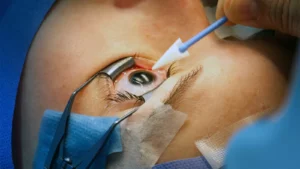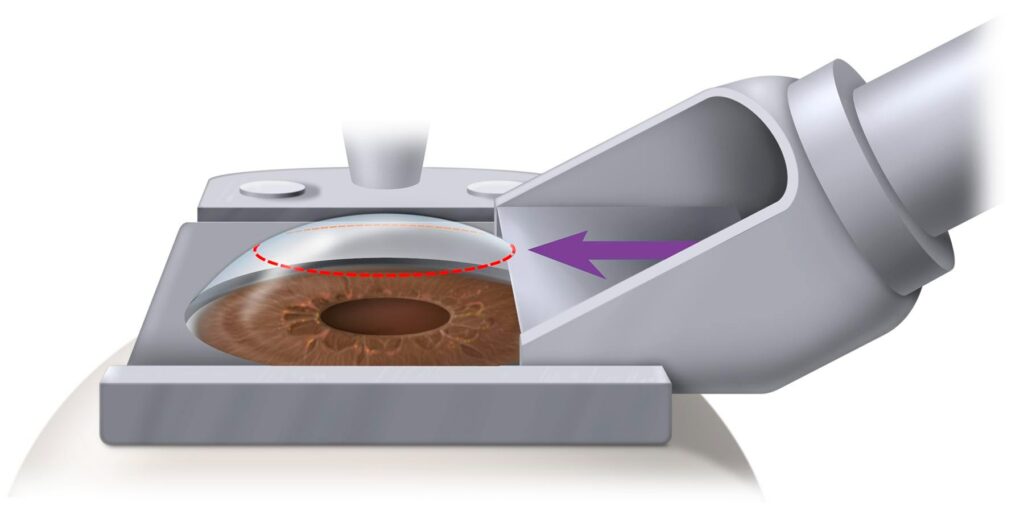If you’re considering laser eye surgery to correct your vision, there are many types you can choose from. One of the types of LASIK is Microkeratome LASIK. In this blog, we’ll explore the ins and outs of this well-established procedure. From understanding how it works to discuss its potential benefits and drawbacks, we’ll provide you with valuable insights to help you make an informed decision. Whether you’re seeking a clearer vision or curious about the latest advancements, join us as we delve into the world of Microkeratome LASIK.
Contents
What Is Microkeratome?
 A microkeratome is a specialized surgical instrument used in certain types of laser eye surgery, such as microkeratome Lasik. It creates a thin flap in the cornea, which is the clear front surface of the eye. The word “microkeratome” is from the Greek words “micro” (small) and “keratome” (a cutting instrument for the cornea).
A microkeratome is a specialized surgical instrument used in certain types of laser eye surgery, such as microkeratome Lasik. It creates a thin flap in the cornea, which is the clear front surface of the eye. The word “microkeratome” is from the Greek words “micro” (small) and “keratome” (a cutting instrument for the cornea).
The microkeratome consists of a small oscillating blade that moves back and forth across the cornea, creating a precise incision. The blade is attached to a mechanical device that controls its movement and depth. The surgeon guides the microkeratome to create a thin flap of corneal tissue, typically around 100-160 micrometers in thickness.
The creation of the corneal flap with a microkeratome allows the surgeon to access the underlying corneal tissue for reshaping using an excimer laser. After the corneal tissue is reshaped, the flap is repositioned, acting as a natural bandage for the treated area.
It’s worth noting that microkeratomes were commonly used in the past for laser eye surgeries, but newer techniques such as femtosecond lasers have gained popularity due to their precision and improved safety profile.
How Is Microkeratome LASIK Done?
 The procedure of microkeratome LASIK involves several steps:
The procedure of microkeratome LASIK involves several steps:
- Preparation
Before the procedure, the patient’s eye is numbed with eye drops to ensure comfort. The surgeon may also administer a mild sedative to help the patient relax.
- Creation of the corneal flap
Using a microkeratome, a specialized surgical instrument, the surgeon creates a thin flap on the cornea. The microkeratome is positioned on the eye, and the oscillating blade moves back and forth, creating a precise incision. The surgeon carefully guides the microkeratome to create a flap of corneal tissue, usually around 100-160 micrometers thick.
- Folding back the flap
Once the corneal flap is created, the surgeon gently lifts and folds it back, exposing the underlying corneal tissue.
- Reshaping the cornea
With the corneal tissue exposed, an excimer laser is used to remove a precise amount of tissue from the cornea. The excimer laser emits cool ultraviolet light, which precisely removes microscopic amounts of tissue without generating heat or causing damage to the surrounding area. The laser reshapes the cornea based on the patient’s specific refractive error.
- Repositioning the corneal flap
After the corneal tissue has been reshaped, the surgeon carefully repositions the corneal flap back into its original position. The flap adheres naturally without the need for sutures.
- Post-operative care
Following the procedure, the patient may be given additional eye drops to aid in the healing process and prevent infection. The surgeon may also place a protective shield over the treated eye for a short period. Patients are typically advised to rest for a few hours and avoid strenuous activities for a few days.
Benefits Of Microkeratome LASIK
 Microkeratome LASIK, despite being less common than newer techniques, has had several benefits for patients in the past. Here are some potential advantages of microkeratome LASIK:
Microkeratome LASIK, despite being less common than newer techniques, has had several benefits for patients in the past. Here are some potential advantages of microkeratome LASIK:
- Established procedure: Microkeratome LASIK has been performed for many years and has a long track record of successful outcomes. It has undergone extensive research and has been refined over time, making it a well-established and trusted procedure.
- Rapid procedure: The creation of the corneal flap using a microkeratome is a relatively quick process, typically taking only a few seconds. This allows for a shorter overall surgical time, reducing the time the patient spends under the laser.
- Lower risk of complications: Some studies have suggested that microkeratome LASIK may have a lower risk of certain complications, such as light sensitivity and dry eye symptoms, compared to other techniques. However, it’s important to note that newer techniques have significantly improved in terms of safety and complication rates.
- Cost: Microkeratome LASIK may be more cost-effective if we compare it to other advanced techniques. Such as bladeless LASIK or femtosecond LASIK. It could be a more affordable option for individuals seeking laser eye surgery.
Disadvantages Of Microkeratome LASIK
 Microkeratome LASIK, despite its advantages, also has several disadvantages.
Microkeratome LASIK, despite its advantages, also has several disadvantages.
Firstly, the creation of the corneal flap with a microkeratome involves the use of a mechanical blade, which can introduce potential complications. There is a risk of flap irregularities, such as an uneven thickness or an incomplete flap, which may affect the accuracy of the procedure.
Additionally, the use of a microkeratome increases the likelihood of flap-related issues such as epithelial ingrowth (growth of cells under the flap) or flap dislocation.
Moreover, the microkeratome blade creates a larger incision compared to newer bladeless techniques, which may lead to increased healing time and a higher risk of corneal complications.
It’s important to note that microkeratome LASIK has become less common in recent years, as newer techniques such as bladeless LASIK (using femtosecond lasers) have gained popularity due to their increased precision and safety profile.
Eligibility Conditions To Undergo Microkeratome LASIK
 The eligibility conditions for microkeratome LASIK, like any other form of laser eye surgery, depend on a comprehensive eye examination. While specific criteria may vary depending on the surgeon and the patient’s circumstances, here are some general factors to consider when assessing eligibility for microkeratome LASIK:
The eligibility conditions for microkeratome LASIK, like any other form of laser eye surgery, depend on a comprehensive eye examination. While specific criteria may vary depending on the surgeon and the patient’s circumstances, here are some general factors to consider when assessing eligibility for microkeratome LASIK:
- Age: Microkeratome LASIK is generally for individuals who are at least 18 years old. This is because the eyes continue to develop and change throughout adolescence. Also, it is important to ensure that the refractive error has stabilized before considering surgery. However, the specific age requirement may vary depending on the surgeon’s discretion.
- Healthy eyes: Candidates should have generally healthy eyes, free from conditions such as cataracts, glaucoma, keratoconus (a progressive corneal disorder), and other significant eye diseases. The cornea should have sufficient thickness to allow for the creation of a corneal flap.
- Good overall health: Candidates should have good overall health, as certain medical conditions and medications can affect the healing process and increase the risks associated with surgery. It is important to disclose any pre-existing medical conditions, medications, or allergies to the surgeon during the evaluation.
Conclusion
In conclusion, Microkeratome LASIK is a well-established laser eye surgery technique that can effectively correct refractive errors. While it has advantages such as a long track record and rapid procedure, there are also potential disadvantages to consider, including flap-related complications and limited customization. It is crucial to consult with an experienced eye surgeon to assess your eligibility, discuss the risks and benefits, and explore alternative options. Seeking professional help is essential for making an informed decision about your vision correction journey.
Lasik surgery is a safe 10-minute procedure to help you get rid of glasses. EyeMantra offers the most advanced LASIK options including PRK, Femto LASIK, SMILE surgery, Standard LASIK, ICL, and Contoura vision. If you have any questions on LASIK surgery in Delhi, Lasik surgery cost, and Lasik procedure, call us at 9711116605 or email at [email protected].


